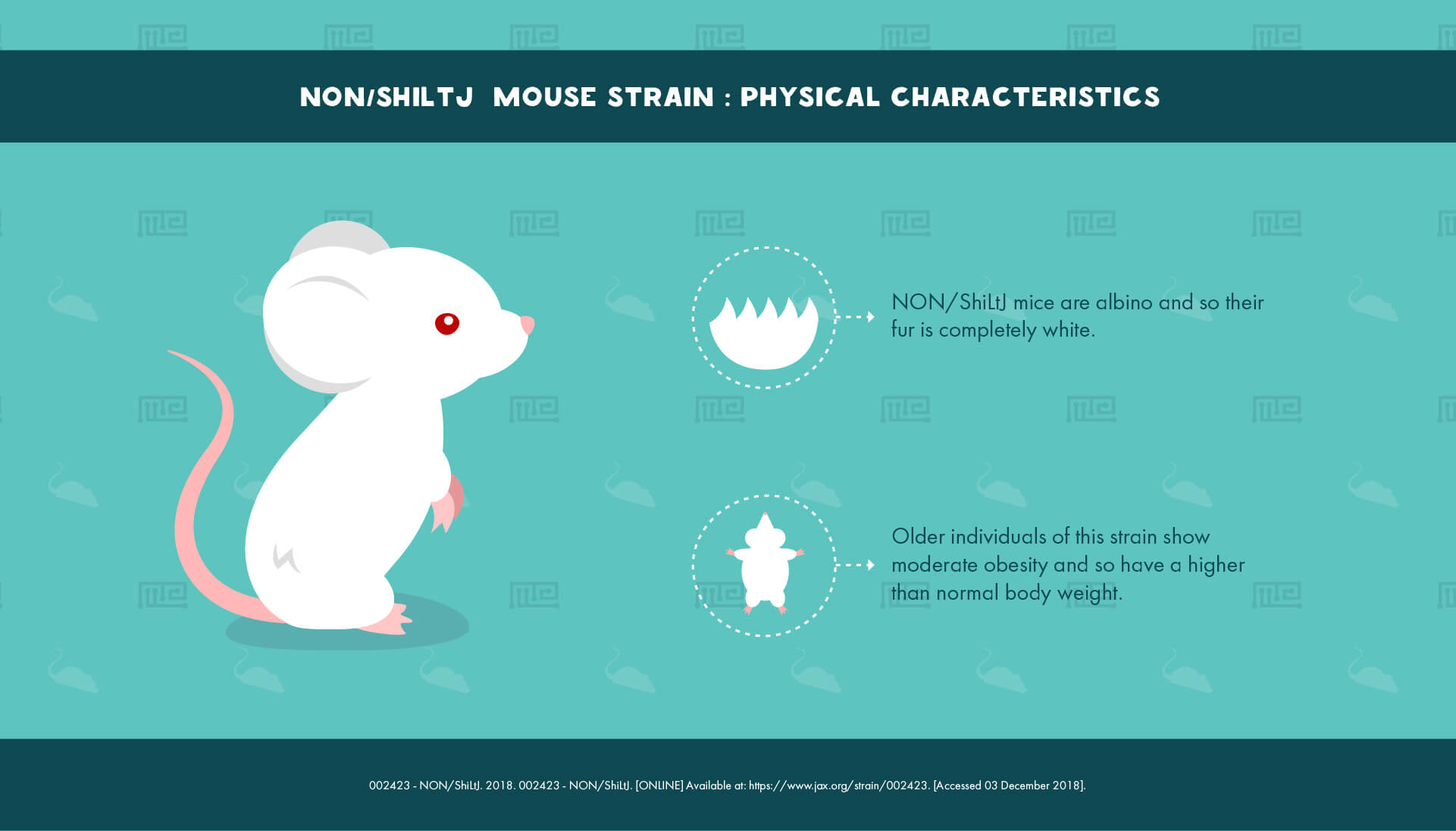Overview
NON/ShiLtJ, also known as NON, and not to be confused with NOD/ShiLtJ, is a strain of mouse model that is related to the NOD strain but exhibits resistance to diabetes.[1]
History
NON/ShiLtJ (non-obese non-diabetic) shares its origins with the very closely related NOD/ShiLtJ (non-obese diabetic). A stock of outbred Jcl:ICR mice were inbred to create the Cataract Shionogi. The immediate progenitors of the NOD strain spontaneously emerged during Cataract Shiogi inbreeding.
These NOD progenitors were selectively inbred for their diabetic phenotype, but some offspring persisted in having a non-diabetic phenotype. These mice, the immediate ancestors of the NON/ShiLtJ strain were separated from the NOD mice at generation thirteen.[2]
Both NOD and NON were imported to the United States from Kyoto, Japan in 1984, arriving at Boston’s Joslin Diabetes Center. These were then sent to Leiter at the Jackson Laboratory, who used them to generate the current NOD/ShiLtJ and NON/ShiLtJ lines. The development of new crosses with the NON/ShiLtJ strain is currently underway at the Jackson Laboratory.[1]
Physical Characteristics
Like NOD mice, NON/ShiLtJ mice are albino and so their fur is completely white. Older individuals show moderate obesity (see below) and so have a higher than normal body weight.[1]
Behavioral Characteristics & Handling
The Jackson Laboratory Handbook describes this strain as “aggressive”, although it is not specified whether this refers to intra-strain aggression or aggression towards handlers. Either way, researchers requiring a highly docile strain should not choose NON/ShiLtJ. The Handbook also cautions that they have a tendency to play with their food.[3]
One study looked into the expertise capacity of a number of mouse strains and found that while NON/ShiLtJ was not a very sedentary strain, it responded the worst of all strains measured to exercise training on a treadmill.[4] Since this strain is moderately obese, researchers may want to avoid it for paradigms involving a high degree of physical exertion such as rotarod or forced swim.
Health Characteristics
The notable resistance to diabetes of the NON/ShiLtJ strain results from their possession of a particular major histocompatibility complex (MHC) haplotype. The MHC is central to immune function, and in this strain is protective against the destruction of the pancreatic islet cells seen in a diabetic phenotype.
Nonetheless, NON/ShiLtJ mice do display numerous marked immunological abnormalities, specifically autoimmunity. When they are crossed with NOD/ShiLtJ, their offspring exhibit an autoimmune diabetes mellitus type 1, most likely as a result of low insulin levels in their plasma. NON/ShiLtJ mice also show infiltration of leukocytes into the pancreas and salivary glands, and T cells can be detected in their spleen from the age of 20 weeks.
These mice express genes that confer a phenotype similar in some ways to type 2 diabetes mellitus, as shown by reduced glucose tolerance in both genders from an early age, their tendency to become obese, and the lesions often found in the glomeruli of their kidneys.
Like many inbred strains, NON/ShiLtJ mice also express the rd1 mutant allele of the enzyme phosphodiesterase 6b, conferring retinal degeneration from a young age, progressing throughout their lifespan.[1]
Major Experimental Uses
NON/ShiLtJ mice are most useful in the study of both type 1 and type 2 diabetes mellitus. They also find applications in research on immunology, sensory disorders, and obesity, as well as serving as a good control for experiments with related strains such as NOD/ShiLtJ.[1]
References
- 002423 – NON/ShiLtJ. 2018. 002423 – NON/ShiLtJ. [ONLINE] Available at: https://www.jax.org/strain/002423. [Accessed 03 December 2018].
- 001976 – NOD/ShiLtJ. 2018. 001976 – NOD/ShiLtJ. [ONLINE] Available at: https://www.jax.org/strain/001976. [Accessed 03 December 2018].
- The Jackson Laboratory Handbook on Genetically Standardized Mice. 6th ed. 2009. [ONLINE]. Available at: http://jackson.jax.org/rs/444-BUH-304/images/JAX%20Handbook%20Genetically%20Standardized%20Mice.pdf.
- Avila, J. J., Kim, S. K., & Massett, M. P. 2017. Differences in Exercise Capacity and Responses to Training in 24 Inbred Mouse Strains. Frontiers in Physiology. 8, 974.


